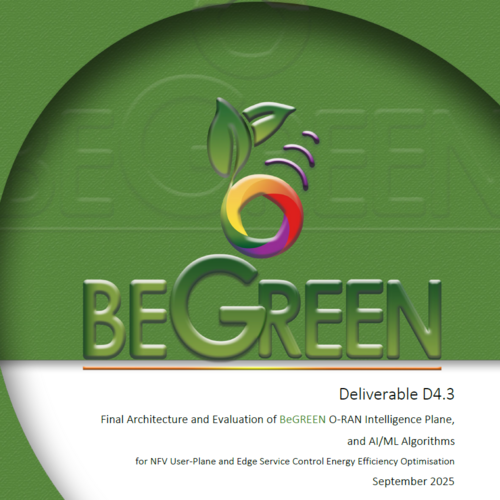D4.3 - Final Architecture and Evaluation of BeGREEN O-RAN Intelligence Plane, and AI/ML Algorithms for NFV User-Plane and Edge Service Control Energy Efficiency Optimisation
About
BeGREEN D4.3, consolidates BeGREEN’s final results on AI/ML-assisted energy efficiency for 5G/6G-ready RANs. It refreshes the Intelligence Plane introduced in BeGREEN D4.2, quantifies the AI/ML plane’s own energy footprint, validates closed-loop control with O-RAN components, and reports end-to-end gains across vRAN, live 5G NSA, relay-enhanced RANs, and edge scenarios hosting UPF and AI services.
Chapter 2 revisits the Intelligence Plane, keeping the core AI Engine with near/non-RT RIC integration while adding hooks for CF-mMIMO and ISAC. Interfaces from BeGREEN D4.2 are preserved; new policies and telemetry enable sensing-assisted control and user-centric coordination. We analyse the energy cost of the AI/ML plane itself—training, serving, storage, orchestration—against the network-side savings it drives, showing that BeGREEN’s lightweight models achieve favourable trade-offs between size, accuracy, and inference rate. Final validations benchmark serving workloads, automate dataset creation and model training with energy metering, and verify AI Engine–RIC workflows on a representative cell on/off loop, including conflict management procedures. Additional scenario validations will be reported in BeGREEN D5.3 as part of PoC#1.
Chapter 3 presents the final evaluation of five AI/ML-assisted methods to enhance energy efficiency. In vRANs, we study cache isolation and LLC utilisation and introduce MemorAI, a lightweight controller that steers cache/CPU to active threads, lowering platform power without harming throughput or latency. For carrier on/off, a compact classifier uses traffic/context features to trigger sleep/activation with guardrails, delivering energy savings without SLA regressions in offline and lab tests. In relay-enhanced RANs, we define RUE identification, compare activation policies, and quantify coverage, sum-rate, and uniformity gains versus no-relay baselines, including detailed power consumption. For UPF, we characterise compute–power curves, validate experimentally, and build a traffic-aware ML policy for scaling and placement that reduces energy on realistic traces at constant QoS. Finally, we jointly orchestrate vRAN and edge-AI services with a multi-objective coordinator that maintains QoS while cutting total energy in static, heterogeneous, and dynamic scenarios.
Chapter 4 concludes that BeGREEN delivers an O-RAN-aligned Intelligence Plane extended for CF-mMIMO/ISAC, practical guidance to ensure the AI plane yields net energy savings, and validated AI-driven procedures that reduce energy without QoS penalties. The accompanying assets—configurations, policies, measurement scripts—are ready for replication in PoCs (D5.3) and for transfer to standardisation and industry pilots.
Editor
Joss Armstrong (LMI)





